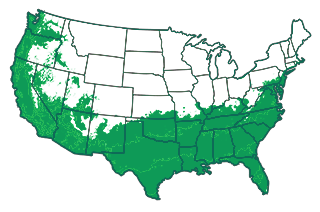About
Blending exotic beauty with delicious flavor, Panache Tiger Fig trees are a show-stopping choice for any garden.How tall does a Panache Tiger Fig tree grow?
A mature Panache Tiger Fig tree typically reaches heights of 12 to 20 feet, making it an ideal choice for gardens seeking a medium-sized fruit tree. Its impressive height is complemented by a broad canopy that provides ample foliage and fruit. This size ensures an eye-catching presence without overwhelming a garden space.How long does a Panache Tiger Fig tree live?
Panache Tiger Fig trees can live for several decades, providing long-term beauty and bounty for gardeners who care for them properly. With the right soil conditions, watering, and maintenance, these fig trees continue to thrive and produce fruit for many years. Their longevity makes them a valuable investment in any garden landscape.How fast do Panache Tiger Fig trees grow?
The Panache Tiger Fig tree boasts a moderate growth rate, gaining around 13 to 24 inches per year under optimal conditions. This steady growth rate allows gardeners to enjoy the development and gradual maturation of their tree. With proper care, this fig tree will establish itself quickly and begin producing its characteristic striped fruit within a few growing seasons.How to care for Panache Tiger Fig trees?
Caring for Panache Tiger Fig trees involves providing sufficient sunlight, regular watering, and balanced fertilization to ensure healthy growth and fruit production. While these trees prefer warm climates, adequate protection from harsh winter conditions is necessary to prevent frost damage. Mulching around the tree base helps retain moisture and regulate soil temperature. Monitoring for pests and diseases, along with regular pruning, ensures the tree remains strong and productive.When to prune Panache Tiger Fig trees?
The optimal time to prune Panache Tiger Fig trees is during late winter or early spring, just before new growth emerges. Pruning during this period helps shape the tree and stimulate robust growth for the upcoming growing season. Regular pruning throughout the year can be done to remove any damaged or diseased branches and maintain the tree’s health.How to prune Panache Tiger Fig trees?
Begin by removing any dead or unhealthy wood, followed by branches that cross or compete for light, to ensure better air circulation and sunlight penetration. Aim to shape the tree into an open, vase-like form, which promotes even ripening of fruit and reduces disease risk. Always use clean, sharp pruning tools to make precise cuts, minimizing damage and promoting quick healing.Why do we like Panache Tiger Fig?
We love Panache Tiger Fig trees for their striking, striped appearance and the delectable, sweet fruit they produce. Their versatility and ability to adapt to different climates make them a prized addition to any garden, offering both aesthetic appeal and practical benefits.| Mature Size | 12–20 ft tall × 12–20 ft wide |
| Sunlight | Full (6-8 hours) |
| Spacing | 12–18 ft |
| Harvest Season | August to September |
| Pollination | Self-pollinating |
| Uses | Fresh eating, preserves, baking |
| Water Requirements | Moderate; moist, well-drained soil |

Growing Zone: 7-10
To plant your Panache Tiger Fig tree, select a location with full sunlight and well-draining soil to ensure optimal growth. Dig a hole twice as wide and as deep as the root ball, gently placing the tree into the hole and spreading the roots. Fill the hole with soil, tamping down lightly and water thoroughly to eliminate air pockets and establish roots.
The best time to plant Panache Tiger Fig trees is in early spring after the last frost, allowing the tree ample time to establish roots before the growing season. In regions with milder climates, fall planting is also possible, providing the tree with cool weather to settle in. Spring planting ensures the tree is ready to take full advantage of the active growing season.
Panache Tiger Fig trees should be planted 12 to 18 feet apart to allow space for their mature size and ensure proper air circulation. This spacing helps maintain healthy growth by preventing overcrowding and reduces the risk of diseases that thrive in humid conditions. Adequate distance between trees also allows for easier maintenance and harvesting.


